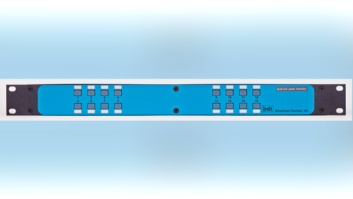Broadcast and video production systems are moving rapidly into the IP realm. Therefore, understanding IP basics is now part of the engineer’s toolkit. To understand how IP works, we need to understand some of the numbering systems that are used.
OSI REFERENCE MODEL AND TCP/IP SUITE
The OSI Reference Model was developed as a framework for moving data through a system, each layer interoperating with its adjacent layers while remaining agnostic to other layers. Its seven layers are listed below with information about their functions.
The TCP/IP suite’s functional equivalents are shown in the far right column. Even though the TCP/IP suite is more commonly used in practice, when you hear someone talking about Layer 2, Layer 3, etc., they are talking about the OSI Model.
To remember the layers from the bottom up, remember Please Do Not Throw Sausage Pizza Away. Top down, remember Angry People Seem To Never Dance Properly, necessarily incorporating the split infinitive.
BINARY NUMBERS
Computers think in binary. To understand IP addressing and subnetting, you need to understand binary. For IPv4 addressing, we use 8-bit binary numbers.
We all understand how to count to nine. After nine, we need another digit. We call this decimal, or the Base 10 numbering system. If we raise 10 to a power, zeros following the one are equal in number to the power. Consider 10 = 100, or 10 = 1000. Any number to the zero power is equal to one.
Making a table, we see:
In binary, there are two possible values for any digit, zero (0) or one (1). When we count in binary, we want to translate to decimal because we think in decimal. To make this work, we give a Decimal Weight (DW) to each digit in a binary number.
The weight of each binary bit is twice the value of its neighbor to the right. This is based on the number 2 raised to the power of one less than the decimal weight’s position, going from right to left. In Table 3 below, DW is Decimal Weight and DWP is Decimal Weight Position.
To calculate the decimal value of a binary number, you just add up the decimal weights of the bits whose values are one. Here are some examples.
If the binary value is one, we add the DW to the total value. Example 1 is 64+32+16+8+4+2=126.
Can you see there are 256 possible values in an 8-bit binary number? They range from 0–255. Since there’s no 256, we carry, incrementing the number to the left by one and setting the value 256 back to zero. Let’s increase the IP address 192.168.2.255 by one. After carrying, you get 192.168.3.0. In binary, using only the last two octets, we have:
2.255 = 00000010.11111111, adding one results in
3.0 = 00000011.00000000
As you can see, there are exactly 10 kinds of people in the world. There are those who understand binary, and those who don’t.
A BRIEF DISCUSSION OF HEXADECIMAL
IP addresses are represented as “human readable” dotted decimal numbers. They also can be represented as hexadecimal numbers.
Hexadecimal numbers are normally prefixed 0x followed by the hexadecimal number. Hex numbers range from decimal equivalents of 0 –15, representing 16 possible values. Hex numbers above 9 are assigned figures of A through F, where A is 10 and F is 15, etc.
A binary number of 1001 is equal to 9 in both decimal and hexadecimal. The most significant binary digit (bit) has a weight of 8, the least has a weight of 1, therefore 9. 1010, then, would be 10 in decimal and A in Hex. These two Hex numbers would properly be shown as 0x9 and 0xA, respectively. 1111 in binary is equal to 0xF, and 15 decimal.
Two binary 4-bit words can be represented by two Hex characters. Binary 11111111 equals 0xFF or 255 decimal. Binary 11111110 is 0xFE or 254 decimal. A string of sixteen ones in binary (2^) is 0xFFFF in Hex. In decimal, that’s 65,536.
IP ADDRESSING
There are two IP addressing schemes. The classical form is IPv4, consisting of four octets (so named because they each have eight binary data bits), each separated by a period. An example might be 192.168.2.34. This is called “dotted decimal format.” Four octets make 32 data bits to an IPv4 address.
IPv4 has limited expansion capability because more IP addresses are needed than can be had with 32 bits. Thus, IPv6 was developed with address space (I have heard), is sufficient to count all the stars in the known universe, with room left over. The total number of available addresses is 2 or approximately 3.4 x 10. With 2^ available addresses, an IPv6 address utilizes a 128-bit address space. It’s formatted as eight groups of four hexadecimal digits separated by colons, such as 2001:0BD7:BC10:EF01:0000:0000:0000:0000. Sometimes there’s a double colon in the middle. Each of the eight groups is a 16-bit number in binary.
For the foreseeable future, IPv4 will be the protocol in broadcast and video production facilities.
IPv4 ADDRESS CLASSES
There are three classes of IP addresses called Class A, Class B, and Class C. There are two additional reserved classes, D and E, which are not part of this discussion. The first few bits of the first octet of an IP address defines the IP address class:
The first octet is always part of the network address.
Class A addresses start with binary 0. The first octet ranges from binary 00000000 to 01111110, or 0 to 126 in decimal. The 127 address space (01111111) is reserved for loopback testing. Addresses in this range may not be assigned to a network.
Class B addresses start with binary 10. The first octet may range from binary 10000000 to 10111111, or 128–191 decimal.
Class C addresses start with binary 110. The first octet may range from binary 11000000 to 11011111, or 192–223 decimal.
PUBLIC IP ADDRESSES
Each class of IP addresses includes blocks of addresses for use on the public Internet and blocks for private use. Private addresses will not be routed on the public internet. The ranges of public IP addresses are:
These addresses are assigned via an ISP who has collaborated with an appropriate regional registry. These registries are operated by:
- APNIC (Asia Pacific Network Information Center)
- ARIN (American Registry for Internet Numbers)
- RIPE NCC (Reseaux IP Europeens Network Coordination Centre)
PRIVATE IP ADDRESSES
Because of rapid Internet growth, new technologies have been developed. These include IPv6, Network Address Translation (NAT), and Classless Inter-Domain Routing (CIDR). CIDR resulted from setting aside blocks of address spaces for private use, not to be used on the public Internet. These address spaces are:
These three blocks of IP addresses are for private use. There is one Class A network, 16 Class B Networks and 256 Class C networks within this schema. When a device assigned a private address communicates with the public internet, the private address is translated to a public address. This process is via Network Address Translation, or NAT. This service is often provided via a router.







